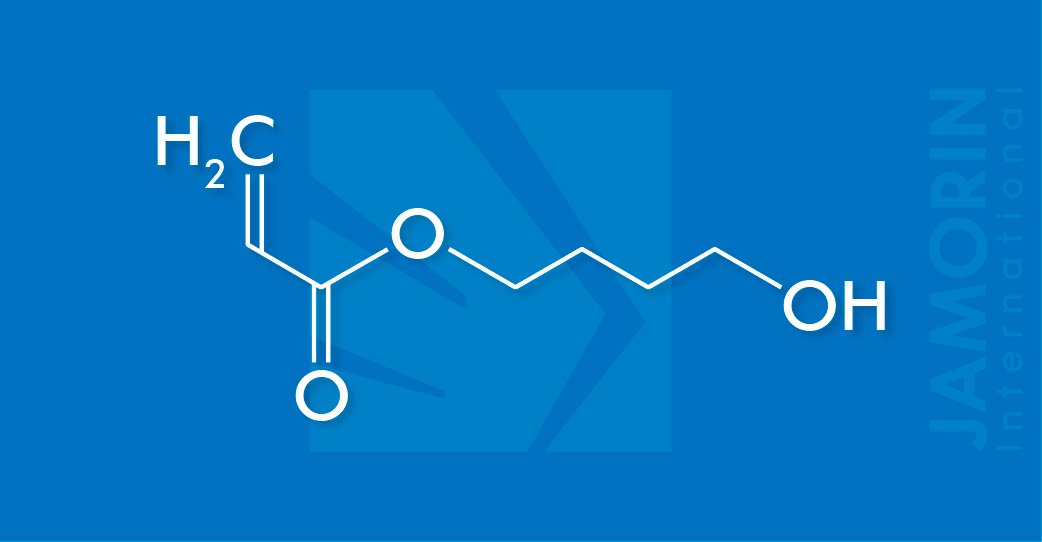C7H12O3
min. 97%
C7H12O3
min. 97%
4-Hydroxybutyl Acrylate (4-HBA)
4-Hydroxybutyl Acrylate (4-HBA) is an ester of Acrylic acid and is used as a raw material component in the synthesis of polymers. 4-Hydroxybutyl Acrylate (4-HBA) is a monofunctional acrylate monomer consisting of a methacrylate group with a characteristic high reactivity and a cyclic hydrophobic group. 4-Hydroxybutyl Acrylate (4-HBA) forms homopolymers. Copolymers of 4-Hydroxybutyl Acrylate (4-HBA) can be prepared with (met)acrylic acid and its salts, amides, and esters, and with methacrylates, acrylonitrile, maleic acid esters, vinyl acetate, vinyl chloride, vinylidene chloride, styrene, butadiene, unsaturated polyesters and drying oils, etc.
4-Hydroxybutyl Acrylate (4-HBA) is also a very useful feedstock for chemical syntheses because it readily undergoes addition reactions with a wide variety of organic and inorganic compounds. The monomer can be used to impart the following properties to polymers:
Product type: Hydroxyl-containing Acrylate Monomer
Features & Benefits:
- Adhesion
- Crosslinking
- Scratch resistance
- Weatherability
- Rheology modifier
- Low VOC
It is applied in the production of:
- Automotive Coatings
- Industrial Coatings
- Plastics
- Adhesives
- UV Curables
Chemical Properties:
-
Puritymin. 97%
-
Acid Valuemax. 0.5%
-
Water contentmax. 0.15%
-
Color APHAmax. 50
Physical Properties:
-
Appearanceclear, colorless or slightly yellowish
-
Physical formliquid
-
Odorodor-free
-
Molecular weight144.17 g/mol
-
Polymer Tg-
-
Tg-
-
Density1.039 g/cm3 at 25°C
-
Boiling Point209°C
-
Freezing Point– 60°C
-
Flash point111°C
-
Melting Point– 60°C
-
Viscosity8.9 mPa · s at 20°C
-
Vapor Point0.005 mbar / 1.3 mbar / 4.6 mbar at 20 / 80 / 100°C
-
pHWeakly acidic
In order to prevent polymerization, 4-Hydroxybutyl Acrylate (4-HBA) must always be stored under air, and never under inert gases. The presence of oxygen is required for the stabilizer to function effectively. In order to minimize the likelihood of overstorage, the storage procedure should strictly follow the “first-in-first-out” principle. For extended storage periods over 4 weeks, it is advisable to replenish the dissolved oxygen content. The storage temperature for 4-Hydroxybutyl Acrylate (4-HBA) should not exceed 25 °C. Under these conditions, the storage stability of six months can be expected upon delivery. If the storage temperature during storage is controlled to be less than 10 °C and the dissolved oxygen has been replenished storage stability of 12 months can be expected upon delivery. The preferred construction material for tanks and pipes is stainless steel. Carbon steel is also acceptable, although the formation of rust may be a problem with product quality (color). Iron(III)-ions have been shown to be a weak polymerization initiator. If carbon steel is to be used, special procedures should be used to prepare the tank for use. Storage tanks, pumps, and pipes should be earthed.
Storage & Handling:
In order to prevent polymerization, 4-Hydroxybutyl Acrylate (4-HBA) must always be stored under air, and never under inert gases. The presence of oxygen is required for the stabilizer to function effectively. In order to minimize the likelihood of overstorage, the storage procedure should strictly follow the “first-in-first-out” principle. For extended storage periods over 4 weeks, it is advisable to replenish the dissolved oxygen content. The storage temperature for 4-Hydroxybutyl Acrylate (4-HBA) should not exceed 25 °C. Under these conditions, the storage stability of six months can be expected upon delivery. If the storage temperature during storage is controlled to be less than 10 °C and the dissolved oxygen has been replenished storage stability of 12 months can be expected upon delivery. The preferred construction material for tanks and pipes is stainless steel. Carbon steel is also acceptable, although the formation of rust may be a problem with product quality (color). Iron(III)-ions have been shown to be a weak polymerization initiator. If carbon steel is to be used, special procedures should be used to prepare the tank for use. Storage tanks, pumps, and pipes should be earthed.
A Safety Data Sheet has been compiled for 4-Hydroxybutyl Acrylate (4-HBA) that contains up-to-date information on questions relevant to safety.
4-Hydroxybutyl Acrylate (4-HBA) polymerizes very readily. It is therefore generally stabilized by using air like a blanket gas and by the addition of 300 ppm Hydroquinone Monomethyl Ether (MEHQ). It is only ever supplied in its stabilized form because it can polymerize with explosive violence if it is not stabilized. It is not usually necessary to remove the stabilizer because its action can be compensated for by adding an excess of the initiator.
The data contained in this publication are based on our current knowledge and experience. In view of the many factors that may affect the processing and application of our product, these data do not relieve processors from carrying out their own investigations and tests; neither do these data imply any guarantee of certain properties, nor the suitability of the product for a specific purpose. Any descriptions, drawings, photographs, data, proportions, weights, etc. given herein may change without prior information and do not constitute the agreed contractual quality of the product. It is the responsibility of the recipient of our products to ensure that any proprietary rights and existing laws and legislation are observed.
